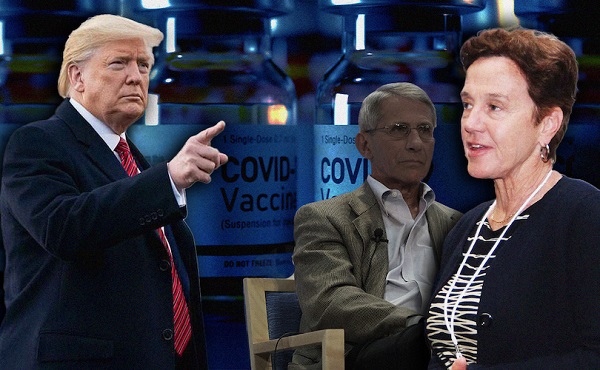Frontier Centre for Public Policy
The Destructive Legacy of Gender Theory’s Popular Pioneer

From the Frontier Centre for Public Policy
By Lee Harding
The idea that gender is disconnected from sex was popularized by psychologist John Money. Perverted minds produce perverted ideas. Unfortunately, Money’s legacy of destruction continues.
The idea that sex drives come out of nowhere and have nothing to do with biology should be dismissed out of hand, given the countless generations of procreated human and even animal species. Yet, in 1961, Money claimed that “erotic outlook and orientation is an autonomous psychological phenomenon independent of genes and hormones.”
Money later said that “like hermaphrodites, all the human race follow the same pattern, namely, of psychological undifferentiation at birth.”
In other words, no one is born heterosexual, and there are no biology-based differences in how men and women act. By 1973, even Money had to acknowledge a wide body of research that showed “fetal gonadal hormones . . . have an influence on neural pathways in the brain.” Still, he emphasized nurture over nature.
Money had a chance to test his theories after the birth of Winnipeg twin brothers Bruce and Ron Reimer, born in 1965. A botched circumcision left Bruce’s penis almost severed, seemingly damaged beyond function. Their parents saw Money on TV in 1967 and went to his gender clinic at Johns Hopkins University.
The clinic was the first of its kind and specialized in cross-sex surgeries. Money convinced the parents to have Bruce’s penis and testes removed, rename him Brenda, and raise him as a girl. Both twins visited Money annually, and Money used their example on a lecture circuit to insist that gender roles were instilled and not innate.
This was complete fiction, but the truth didn’t come out until it was exposed by psychologist H. Keith Sigmundson and biologist Milton Diamond in a medical journal in 1997.
The twins’ mother Janet recalled how Brenda hated dresses, sewing, and dolls. Instead, the child preferred to play soldier, dress in men’s clothes, tinker with tools and gadgets, and even stand up to pee. When Brenda told doctors “she” felt she wasn’t a girl, they discounted it.
It turns out Money made the twins inspect each other’s genitals. His therapy involved forcing the twins into a simulation of sexual positions and motions, something Money justified as healthy childhood sexual exploration. Money photographed this while as many as six colleagues looked in person. If either child resisted orders, the doctor responded with anger and verbal abuse.
This disturbing account is not entirely surprising. Money participated in nudism and group sex as part of the Society for the Scientific Study of Sexuality. He advocated open marriages and even compiled a pornographic presentation for students at Johns Hopkins Medical School called “Pornography in the Home.”
In his 1975 book Sexual Signatures, Money wrote, “[E]xplicit sexual pictures can and should be used as part of a child’s sex education…. [to] reinforce his or her own gender identity/role,” Money explained.
By the age of 13, Brenda so dreaded the annual visit to Money that she threatened suicide. Her parents sent her anyway. Consultants at the Baltimore clinic recruited male-to-female transsexuals to convince Reimer it was better to be female and have a vagina. This so disturbed Reimer, that she ran away from the hospital and hid on the roof of a nearby building.
In 1980, Reimer begged her father to know the truth and he finally admitted her birth as a male. The family moved and the child took the name David. Next, endocrinologists, psychologists, and surgeons did their best to reconstruct Reimer’s manliness. Money stopped talking about the twins on the lecture circuit but did not confess how woefully wrong he was.
In 1979, Dr. Paul McHugh, chief psychiatrist at Johns Hopkins Hospital, investigated whether their sex reassignment surgeries helped the psycho-social problems of patients. The answer was so clearly “no” that the clinic stopped doing them.
In 2004, McHugh recalled that those operated on “had much the same problems with relationships, work, and emotions as before.” He added, “I concluded that Hopkins was fundamentally cooperating with a mental illness. We psychiatrists, I thought, would do better to concentrate on trying to fix their minds and not their genitalia.”
When the gender clinic was shut down in 1980, Money started another clinic at Johns Hopkins for gender “paraphilias,” a polite term for deviancies. That year, he told Time magazine, “A childhood sexual experience, such as being the partner of a relative or of an older person, need not necessarily affect the child adversely.”
In 1991, Money told Paidika, a pro-pedophilia journal in the Netherlands that a mutually acceptable sexual relationship between a ten-year-old boy and a man in his 30s was not “pathological in any way.” He said efforts to keep children from sexual activity, including sexual consent laws, was “really a diabolically clever ploy to establish anti-sexualism on a big scale.”
David Reimer killed himself in 2004, while Money died in 2006. Too bad the psychologist’s warped ideas didn’t die with him. In practice, they lead to futility and failure.
Lee Harding is a Research Fellow for the Frontier Centre for Public Policy.
Education
Our Kids Are Struggling To Read. Phonics Is The Easy Fix

From the Frontier Centre for Public Policy
One Manitoba school division is proving phonics works
If students don’t learn how to read in school, not much else that happens there is going to matter.
This might be a harsh way of putting it, but it’s the truth. Being unable to read makes it nearly impossible to function in society. Reading is foundational to everything, even mathematics.
That’s why Canadians across the country should be paying attention to what’s happening in Manitoba’s Evergreen School Division. Located in the Interlake region, including communities like Gimli, Arborg and Winnipeg Beach, Evergreen has completely overhauled its approach to reading instruction—and the early results are promising.
Instead of continuing with costly and ineffective methods like Reading Recovery and balanced literacy, Evergreen has adopted a structured literacy approach, putting phonics back at the centre of reading instruction.
Direct and explicit phonics instruction teaches students how to sound out the letters in words. Rather than guessing words from pictures or context, children are taught to decode the language itself. It’s simple, evidence-based, and long overdue.
In just one year, Evergreen schools saw measurable gains. A research firm evaluating the program found that five per cent more kindergarten to Grade 6 students were reading at grade level than the previous year. For a single year of change, that’s a significant improvement.
This should not be surprising. The science behind phonics instruction has been clear for decades. In the 1960s, Dr. Jeanne Chall, director of the Harvard Reading Laboratory, conducted extensive research into reading methods and concluded that systematic phonics instruction produces the strongest results.
Today, this evidence-based method is often referred to as the “science of reading” because the evidence overwhelmingly supports its effectiveness. While debates continue in many areas of education, this one is largely settled. Students need to be explicitly taught how to read using phonics—and the earlier, the better.
Yet Evergreen stands nearly alone. Manitoba’s Department of Education does not mandate phonics in its public schools. In fact, it largely avoids taking a stance on the issue at all. This silence is a disservice to students—and it’s a missed opportunity for genuine reform.
At the recent Manitoba School Boards Association convention, Evergreen trustees succeeded in passing an emergency motion calling on the association to lobby education faculties to ensure that new teachers are trained in systematic phonics instruction. It’s a critical first step—and one that should be replicated in every province.
It’s a travesty that the most effective reading method isn’t even taught in many teacher education programs. If new teachers aren’t trained in phonics, they’ll struggle to teach their students how to read—and the cycle of failure will continue.
Imagine what could happen if every province implemented structured literacy from the start of Grade 1. Students would become strong readers earlier, be better equipped for all other subjects, and experience greater success throughout school. Early literacy is a foundation for lifelong learning.
Evergreen School Division deserves credit for following the evidence and prioritizing real results over educational trends. But it shouldn’t be alone in this.
If provinces across Canada want to raise literacy rates and give every child a fair shot at academic success, they need to follow Evergreen’s lead—and they need to do it now.
All students deserve to learn how to read.
Michael Zwaagstra is a public high school teacher and a senior fellow at the Frontier Centre for Public Policy.
Economy
Support For National Pipelines And LNG Projects Gain Momentum, Even In Quebec

From the Frontier Centre for Public Policy
Public opinion on pipelines has shifted. Will Ottawa seize the moment for energy security or let politics stall progress?
The ongoing threats posed by U.S. tariffs on the Canadian economy have caused many Canadians to reconsider the need for national oil pipelines and other major resource projects.
The United States is Canada’s most significant trading partner, and the two countries have enjoyed over a century of peaceful commerce and good relations. However, the onset of tariffs and increasingly hostile rhetoric has made Canadians realize they should not be taking these good relations for granted.
Traditional opposition to energy development has given way to a renewed focus on energy security and domestic self-reliance. Over the last decade, Canadian energy producers have sought to build pipelines to move oil from landlocked Alberta to tidewater, aiming to reduce reliance on U.S. markets and expand exports internationally. Canada’s dependence on the U.S. for energy exports has long affected the prices it can obtain.
One province where this shift is becoming evident is Quebec. Historically, Quebec politicians and environmental interests have vehemently opposed oil and gas development. With an abundance of hydroelectric power, imported oil and gas, and little fossil fuel production, the province has had fewer economic incentives to support the industry.
However, recent polling suggests attitudes are changing. A SOM-La Presse poll from late February found that about 60 per cent of Quebec residents support reviving the Energy East pipeline project, while 61 per cent favour restarting the GNL Quebec natural gas pipeline project, a proposed LNG facility near Saguenay that would export liquefied natural gas to global markets. While support for these projects remains stronger in other parts of the country, this represents a substantial shift in Quebec.
Yet, despite this change, Quebec politicians at both the provincial and federal levels remain out of step with public opinion. The Montreal Economic Institute, a non-partisan think tank, has documented this disconnect for years. There are two key reasons for it: Quebec politicians tend to reflect the perspectives of a Montreal-based Laurentian elite rather than broader provincial sentiment, and entrenched interests such as Hydro-Québec benefit from limiting competition under the guise of environmental concerns.
Not only have Quebec politicians misrepresented public opinion, but they have also claimed to speak for the entire province on energy issues. Premier François Legault and Bloc Québécois Leader Yves-François Blanchet have argued that pipeline projects lack “social licence” from Quebecers.
However, the reality is that the federal government does not need any special license to build oil and gas infrastructure that crosses provincial borders. Under the Constitution, only the federal Parliament has jurisdiction over national pipeline and energy projects.
Despite this authority, no federal government has been willing to impose such a project on a province. Quebec’s history of resisting federal intervention makes this a politically delicate issue. There is also a broader electoral consideration: while it is possible to form a federal government without winning Quebec, its many seats make it a crucial battleground. In a bilingual country, a government that claims to speak for all Canadians benefits from having a presence in Quebec.
Ottawa could impose a national pipeline, but it doesn’t have to. New polling data from Quebec and across Canada suggest Canadians increasingly support projects that enhance energy security and reduce reliance on the United States. The federal government needs to stop speaking only to politicians—especially in Quebec—and take its case directly to the people.
With a federal election on the horizon, politicians of all parties should put national pipelines and natural gas projects on the ballot.
Joseph Quesnel is a senior research fellow with the Frontier Centre for Public Policy.
-

 Business2 days ago
Business2 days agoCalifornia planning to double film tax credits amid industry decline
-

 2025 Federal Election6 hours ago
2025 Federal Election6 hours agoCanada Continues to Miss LNG Opportunities: Why the World Needs Our LNG – and We’re Not Ready
-

 Catherine Herridge2 days ago
Catherine Herridge2 days agoFBI imposed Hunter Biden laptop ‘gag order’ after employee accidentally confirmed authenticity: report
-

 Business1 day ago
Business1 day agoB.C. Credit Downgrade Signals Deepening Fiscal Trouble
-

 COVID-191 day ago
COVID-191 day agoTrump’s new NIH head fires top Fauci allies and COVID shot promoters, including Fauci’s wife
-

 2025 Federal Election1 day ago
2025 Federal Election1 day agoWill Four More Years Of Liberals Prove The West’s Tipping Point?
-

 Freedom Convoy1 day ago
Freedom Convoy1 day agoFreedom Convoy leaders Tamara Lich, Chris Barber found guilty of mischief
-

 Business1 day ago
Business1 day agoTrump’s ‘Liberation Day’ – Good News for Canadian Energy and Great News for WCSB Natural Gas






